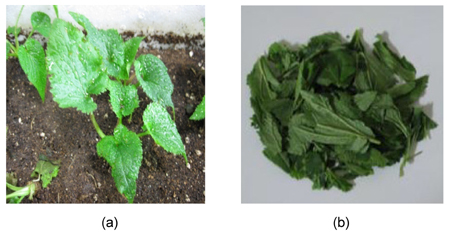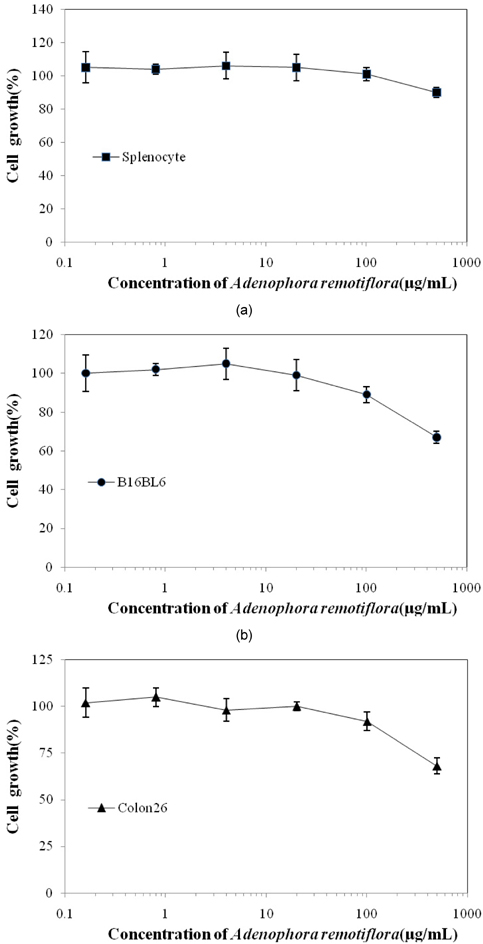Nutr Res Pract.
2010 Feb;4(1):30-35.
The antioxidant and chemopreventive potentialities of Mosidae (Adenophora remotiflora) leaves
- Affiliations
-
- 1Department of Food and Nutrition, Hyejeon College, San 16, Namjang-ri, Hongsung-eup, Hongsung-gun, Choongnam 350-702, Korea. aj5249@naver.com
- 2Department of Food Engineering, Dankook University, Cheonan 330-714, Korea.
- 3Department of Food and Nutrition, Sungshin Women's University, Seoul 130-742, Korea.
- 4Department of Food and Nutrition, Yuhan University, Bucheon 442-749, Korea.
- 5Department of Food Science and Technology, Chung-Ang University, Anseong 456-756, Korea.
Abstract
- Our study focused on the antioxidant activities of Mosidae leaf ethanol extract (MLE) and included measurements of reducing power, total phenolic compounds, DPPH radical scavenging activity, and hydroxyl radical scavenging activity. In order to determine whether or not MLE evidences any chemopreventive activities, experimental lung metastasis was induced via the i.v. inoculation of colon26-M3.1 carcinoma cells into BALB/c mice. Additionally, we attempted to characterize any possible cytotoxic effects in murine normal splenocytes and tumor cells (B16-BL6 and colon26-M3.1). The total phenolic content and reducing capacity were measured at 39 mg/100 mL and 1.24, respectively, whereas the DPPH and hydroxyl radical scavenging activities of MLE were measured to be 88.89% and 22.10%, respectively. Prophylactic i.v. treatment with MLE resulted in a dose-dependent and significant inhibition of lung metastasis. Specifically, a MLE dose of 200 ug per mouse resulted in an 88.90% inhibition of lung metastasis. For the cytotoxicity assay, MLE doses up to 100 ug/mL were not shown to affect the growth of normal murine splenocytes. Additionally, the survival of normal cells was not affected at MLE doses below 500 ug/mL. However, MLE doses up to 500 ug/mL reduced the percentage of tumor cell growth for B16BL6 (67% alive) and colon26-M3.1 (62% alive) cells.
Keyword
MeSH Terms
Figure
Reference
-
1. Fiorentino A, D'Avrosca B, Pacifico S, Mastellone C, Piscopo V, Caputo R, Monaco P. Isolation and structure elucidation of antioxidant polyphenols from quiunce (Cydonia vulgaris) peels. J Agric Food Chem. 2008. 56:2660–2667.
Article2. Valko M, Rhodes CJ, Moncol J, Izakovic M, Mazur M. Free radicals, metals and antioxidants in oxidative stress-induced cancer. Chem Biol Interact. 2006. 160:1–40.
Article3. Valko M, Leibfritz D, Moncol J, Cronin MT, Mazur M, Telser J. Free radicals and antioxidants in normal physiological functions and human disease. Int J Biochem Cell Biol. 2007. 39:44–84.
Article4. Colombo MP, Trinchieri G. Interleukin-12 in anti-tumor immunity and immunotherapy. Cytokine Growth Factor Rev. 2002. 13:155–168.
Article5. Fisher M, Yang LX. Anticancer effects and mechanisms of polysaccharide-K (PSK): Implications of cancer immuno-therapy. Anticancer Res. 2002. 22:1737–1754.6. Saiki I, Saito S, Fujita C, Ishida H, Iida J, Murata J, Hasegawa A, Azuma I. Induction of tumoricidal macrophages and production of cytokines by synthetic muramyl dipeptide analogues. Vaccine. 1998. 6:238–244.
Article7. Yoon TJ, Yoo YC, Lee SW, Shin KS, Choi WH, Hwang SH, Ha ES, Jo SK, Kim SH, Park WM. Anti-metastatic activity of Acanthopanax senticosus extract and its possible immunological mechanism of action. J Ethnopharmacol. 2004. 93:247–253.
Article8. Efferth T, Kaha S, Paulus K, Adams M, Rauh R, Boechzelt H, Hao X, Kaina B, Bauer R. Phytochemistry and pharmacogenomics of natural products derived from traditional Chinese medicine and Chinese materia medica with activity against tumor cells. Mol Cancer Ther. 2008. 7:152–161.
Article9. Schantz SP, Brown BW, Lira E, Taylor SL, Beddingfield N. Evidence for the role of natural immunity in the control of metastatic spread of head and neck cancer. Cancer Immunol Immunother. 1987. 25:141–148.
Article10. Kim SH, Choi HS, Lee MS, Chung MS. Flavor pattern and sensory characteristics of Adenophora remotiflora. Annals of Plant Resources Research, Duksung Women's University. 2007. 260:112–120.11. Kim SH, Choi HS, Lee MS, Chung MS. Volatile compounds and antioxidant activities of Adenophora remotiflora. Korean Journal of Food Science and Technology. 2007. 39:109–113.12. Kim SR, Kim SJ, Kim GH. Quality characteristics of Adenophora remotiflora for increasing the value as a food resource. Institute of Natural Science Research, Duksung Women's University. 2001. 7:117–125.13. AOAC. Official methods of analysis of AOAC. 2005. Washington DC: Association of official analytical chemicals.14. Oyaizu M. Studies on products of browning reactions: antioxidative activities of products of browning reaction prepared from glucosamine. Japanese Journal of Nutrition. 1986. 44:307–315.
Article15. Velioglu YS, Mazza G, Gao L, Oomah BD. Antioxidant activity and total phenolics in selected fruits, vegetables, and grain products. J Agric Food Chem. 1998. 46:4113–4117.
Article16. Huang D, Ou B, Prior RL. The chemistry beind antioxidant capacity assays. J Agric Food Chem. 2005. 53:1841–1856.17. Chung SK, Osawa T, Kawakishi S. Hydroxyl radical scavenging effects of species and scavengers from brown mustard (Brassica nigra). Biosci Biotechnol Biochem. 1997. 61:118–123.
Article18. Yoon TJ, Yoo YC, Choi OB, Do MS, Kang TB, Lee SW, Azuma I, Kim JB. Inhibitory effect Of Korean mistletoe (Viscum album coloratum) extract on tumour angiogenesis and metastasis of haematogenous and non-haematogenous tumour cells in mice. Cancer Lett. 1995. 97:83–91.
Article19. Lee SJ, Saiki I, Hayakawa Y, Nunome S, Yamada H, Kim SH. Antimetastatic and immunomodulating properties of a new herbal prescription, Bojung-bangam-tang. Int Immunopharmacol. 2003. 3:147–157.
Article20. Johnson TM, Yu Z, Ferrangs VJ, Lowenstein RA, Finkel T. Reactive oxygen species are downstream mediators of p53 dependent apoptosis. Proc Natl Acad Sci U S A. 1996. 93:11848–11852.
Article21. Meir S, Kanner J, Akiri B, Hadas SP. Determination and involvement of aqueous reducing compounds in oxidative defense systems of various senescing leaves. J Agric Food Chem. 1995. 43:1813–1817.
Article22. Cho MJ. A study on the antioxidant nutrients analysis and antioxidative activities of Adenophora remotiflora and Aster glehni. 2001. Seoul: Duksung Women's University;master's thesis.23. Rice-Evan C, Miller N, Paganga . Antioxidant properties of phenolic compounds. Trends Plant Sci. 1997. 2:152–159.
Article24. Rininger JA, Kickner S, Chigurupati P, McLean A, Franck Z. Immunopharmacological activity of Echinacea preparations following simulated digestion on murine macrophages and human peripheral blood mononuclear cells. J Leukoc Biol. 2000. 68:503–510.25. Schepetkin IA, Faulkner CL, Nelson-Overton LK, Wiley JA, Quinn MT. Macrophage immunomodulatory activity of polysaccharides isolated from Juniperus scopolorum. Int Immunopharmacol. 2005. 5:1783–1799.
Article26. Gillis CN. Panax ginseng pharmacology: A nitric oxide link? Biochem Pharmacol. 1997. 54:1–20.
Article27. O'Hara M, Kiefer D, Farrell K, Kemper K. A review of 12 commonly used medicinal herbs. Arch Fam Med. 1998. 7:523–536.28. Timothy M, Simi K, Leonard B. Complementary and alternative medicine: herbs, phytochemicals and vitamins and their immunological effects. J Allergy Clin Immunol. 2009. 123:283–294.29. Lee KH, Kim AJ, Choi EM. Antioxidant and anti-inflammatory activity of pine pollen extract in vitro. Phytother Res. 2009. 23:41–48.
Article
- Full Text Links
- Actions
-
Cited
- CITED
-
- Close
- Share
- Similar articles
-
- Adenophora remotiflora protects human skin keratinocytes against UVB-induced photo-damage by regulating antioxidative activity and MMP-1 expression
- Antioxidant Activity and Phenolic Content of Different Parts of Lotus and Optimization of Extraction Condition using Response Surface Methodology
- Total Phenolic Content and Antioxidant Activities of Leaves and Bark Extract of Adenanthera pavonina L.
- Effects of Edible and Medicinal Plants Intake on Blood Glucose, Glycogen and Protein Levels in Streptozotocin Induced Diabetic Rats
- Xanthone and Flavonoid Derivatives from the Leaves of Maclura tricuspidata with Antioxidant and Anti-tyrosinase Activity



